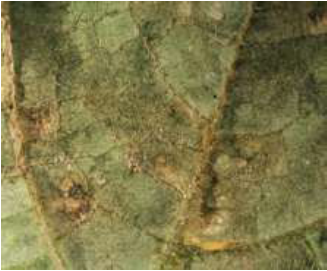Cucurbit Downy Mildew Found in South Carolina
By Anthony Keinath, Vegetable Pathologist, Clemson University, Coastal REC, Charleston, SC
Cucurbit downy mildew has been found on yellow summer squash and zucchini plants at a “big box" store in Charleston, SC. Some plants were likely sold between the dates of first discovery (Wed. 4/6/11) and confirmation (Sun. 4/10/11). Remaining plants were pulled on 4/10/11. Plants were at bloom stage in one-gallon pots with 5-10% severity of downy mildew on about 25% of the leaves. Several spots had begun to sporulate. The plants were grown in Miami, FL, which is the only area in which cucurbit downy mildew has been reported so far this season.
All cucumber, muskmelon, and squash fields in Charleston, Berkeley, and Dorchester counties of South Carolina should be sprayed now using the preventative schedule below. Cucurbit growers in other parts of South Carolina should spray with chlorothalonil or mancozeb and be ready to spray if infected plants are found in their location or if a field outbreak of cucurbit downy mildew develops in South Carolina.
 Symptoms and Signs
Symptoms and Signs
Leaf spots on cucumber and cantaloupe start as pale green to yellow angular spots that turn brown and spread. Leaf spots on squash are small, bright yellow flecks across the leaf surface. Slight yellowing may be seen around the edges of the spots or on other parts of the leaf that are already infected. Brownish-purple spores are found on the bottom of infected leaves in the early morning. They give the under-side of the leaf a “dirty” appearance as seen in the photo from cucumber.
How Downy Mildew Spreads
Downy mildews do not survive on dead tissue or in soil. They can only grow on live plants. Cucurbit downy mildew is spread by air as wind blows spores northward from the south in the spring. Spores spread the farthest and fastest during windy, cloudy periods. Outbreaks are most likely during wet, warm weather.
Currently, cucurbit downy mildew is only found in the field in south Florida and Puerto Rico. See the Cucurbit Downy Mildew Forecast at http://cdm.ipmpipe.org/. Growers, scouts, home owners, and other interested people can sign up to receive e-mail or text message alerts when new outbreaks of downy mildew are reported to the system.
Fungicides
Fungicides are necessary to manage cucurbit downy mildew. Two different fungicide programs are recommended in 2011. The first program is for prevention and should be used before downy mildew is found in a field. The fungicide choices are Gavel (Dow), Tanos (DuPont), and Previcur Flex (Bayer). Tanos and Previcur Flex must be tank-mixed with chlorothalonil or mancozeb.
Once downy mildew hits, two different fungicides need to be used. Apply Ranman (FMC) and Presidio (Valent) mixed with with chlorothalonil or mancozeb alternated weekly. See page 196 of the Southeastern U. S. 2011 Vegetable Crop Handbook or http://www.thegrower.com/south-east-vegetableguide. Organic growers should use copper products but also should expect yield loss in cucumber and muskmelon, because copper is not completely effective against downy mildew. Summer squash has some tolerance to downy mildew. Home gardeners should spray with chlorothalonil or copper.
Cucurbit downy mildew in most parts of the U.S. is resistant to Ridomil, all strobilurin fungicides (Cabrio, Quadris, Flint, Pristine, and Reason), and Revus. These fungicides are not recommended against cucurbit downy mildew.
Follow Us on Facebook
FACTOIDS
Texas Agriculture Matters! Texas watermelons contribute almost $90 million annually to our state’s economy. Grown on farms stretching from the Rio Grande Valley up to the High Plains and from East Texas to the Trans-Pecos, watermelons nourish Texans and the Texas economy – enabling our producers and state to continue to be recognized leaders in the global marketplace.
– Sid Miller, Agriculture Commissioner
The first recorded watermelon harvest occurred nearly 5,000 years ago in Egypt.
Over 1,200 varieties of watermelons are grown worldwide in 96 countries.
Watermelons are 92% water.
Watermelon's official name is Citrullus Lanatus of the botanical family Curcurbitaceae. It is cousins to cucumbers, pumpkins and squash.
By weight, watermelon is the most-consumed melon in the U.S., followed by cantaloupe and honeydew.
Early explorers used watermelons as canteens.
The first cookbook published in the U.S. in 1776 contained a recipe for watermelon rind pickles.
In 1990, Bill Carson of Arrington, TN grew the largest watermelon at 262 pounds that is still on the record books (1998 ed. Guinness Book of World Records).
TEXAS IS ONE OF THE TOP FOUR WATERMELON PRODUCERS IN THE COUNTRY, GROWING 15% OF THE TOTAL DOMESTIC CROP. LAST YEAR, TEXAS PRODUCED OVER 600 MILLION LBS OF WATERMELON.
